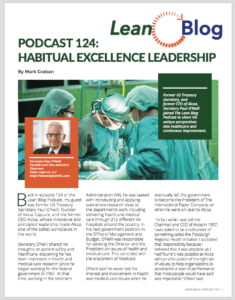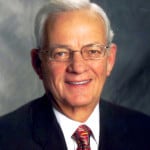Listen
I have a very special guest for Podcast #124 – he is Paul O'Neill, the U.S. Treasury Secretary from 2001 to 2002 and former CEO of Alcoa.
2020 Update: Read my reflections on Mr. O'Neill's passing
Mr. O'Neill shares his thoughts on patient safety and healthcare, including his time spent as the Chair of the Pittsburgh Regional Health Initiative and his work with Dr. Richard Shannon in dramatically reducing hospital-acquired infections to near their “theoretical limit” of zero. Dr. Shannon will be a podcast guest next month. Mr. O'Neill talks about the leadership required to have such an impact on safety and quality, drawing on lessons from his years as Alcoa's CEO.
This podcast was produced in conjunction with the Healthcare Value Network as a continuation of their previous podcast series.
For a link to this episode, refer people to www.leanblog.org/124. Scroll down for quotes in readable form.
Podcast Summary
You can also read and download this 4-page PDF summary of the podcast:

Quotes and Excerpts:
In summary, O'Neill talks about:
- Leadership mindsets required for dramatic workplace safety and patient safety improvement, including a near 100% reduction in hospital-acquired infections at Pittsburgh's Allegheny General Hospital
- Why the United States has accomplished “practically nothing” nationally since the famed 1999 Institute of Medicine report “To Err Is Human”
- Why society's most lacking skill is “leadership”
- Alternative ways of compensating patients who are harmed by the healthcare system while ensuring real improvements are made by learning from each problem
- Why Rep. Paul Ryan (R-WI) needs to shift his focus from “financial engineering” to visiting ThedaCare to learn about “the real way” we should improve health care.
In the podcast, O'Neill was first asked about the workplace safety improvements that took place during his CEO tenure at Alcoa. When this idea of safety improvement was initiated, Alcoa was already in the top 1/3 of U.S. companies for avoiding injuries and their injury rates (as found on the Alcoa health & safety website) are now 30x lower than hospitals, says O'Neill. O'Neill argues this 30x improvement can be achieved in healthcare organizations, but it requires the right leadership and the articulation of goals at the “theoretical limit” (zero harm and zero injuries).
O'Neill then talks about Dr. Richard Shannon, now at the University of Pennsylvania, and how he got interested in this “theoretical limits” approach to improvement from an Alcoa University course that he attended. O'Neill recounts how Dr. Shannon had 39 patients who got infections in 3 ICUs in the 12-month period before the course, with 19 of those patients dying.
Allegheny General Hospital started their infection prevention efforts using these principles:
- get people involved
- get them observing how the care is done
- come to agreement with all about how they would do the work
- do it the same way everyday,
With this approach, if there was an infection, they could more easily understand why that happened.
Over 18 months, they worked in this, and then started measuring for a 12 period. They had 100 more patients than the comparable 12 months, but just 1 infection (not 39) and nobody died. O'Neill said, “Dr. Shannon's experiences were very consistent with my own at Alcoa, that when we got people to practice good ideas and to learn from every instance of anything going wrong, that the process (whatever it was) got better and better and better. And so, even today, Alcoa has maintained the safety culture.”
O'Neill said, “Since 1999, when the Institute of Medicine's famous study was published, called “To Err Is Human,” we've accomplished, on a national basis, practically nothing in terms of reducing things gone wrong in the delivery of health and medical care.”
After mentioning some of the success stories (UPenn, ThedaCare, Virginia Mason), O'Neill continued, “The tragedy is, as straightforward as these ideas are, leadership in health and medical care institutions around the country have not grabbed these ideas and implemented them, which is, frankly, unbelievable when it's so clear that the benefits are not only to significantly better outcomes for health and medical care, but significant cost reductions at the same time.”
The rest of the story is best told in O'Neill's own words, edited in some instances for clarity:
“So, I believe, having observed the practice of caregiving around the country, in a lot of different venues, that if we can get these ideas practiced every day in every caregiving institution in the U.S., we could have an enormous improvement in the outcomes for patients and we could save $1 trillion a year out of the $2.7 trillion we're spending on health and medical care. And that would be unbelievably positive for our society.”
What is getting in the way these ideas and results spreading more quickly?
“I honestly think the skill shortage in our society, maybe in the world of civilized people, is real leadership. There are a whole lot of people who I suppose are leaders by designation, but I don't honestly know a lot of people who are leaders in the sense that they will articulate goals at what I call the theoretical limit and then help their people to acquire and practice the skills that are necessary to what I call habitual excellence. It's really hard to find leaders who understand the concept of habitual excellence, which means a leader should expect every aspect of his organization to perform at the known level of possibility. Having that kind of leadership and a leadership that is not about punishing or blaming people, but about using every single instance of anything gone wrong as a basis for organizational learning is really critical to this. There are a lot of people working on pieces of these ideas but, unfortunately, there isn't a national movement yet. Hopefully, soon there will be.”
On alternatives to the existing medical malpractice system:
“There are several pushbacks to the idea of habitual excellence. One is to say, “well, we can never be perfect, and we don't want to set goals we can't achieve.” I found in my own early days at Alcoa when people told me that about workplace safety, then I said to them, ‘OK, if you don't want to have a goal of zero, then let's go around and find out who wants to volunteer to be hurt to make sure we reach our goal of somebody being hurt. And it's so ridiculous on its face, it's equivalent to people saying, “Oh, there's no way we can eliminate all of the infections in the hospital,” – it's a lie. It is simply not true. To aspire to less [improvement] than [reaching] zero is to excuse every single one that happens rather than learning from them and figuring out a way to introduce practices that take away the possibility [of infections].”
“In the secondary case of medical malpractice, they say, ‘Oh my God, if we start reporting things gone wrong, we're creating a roadmap for the lawyers to come and attack us with our own information. So, I believe there is a legitimate answer to that, and it rests in this observation: if you go around the country and you try to find people who are malevolent malefactors who are intentionally hurting people, I would submit to you that, except for criminally insane people, you can't find any examples of that. You find that people do get hurt in the practice of medicine in the United States… the answer is yes.
So, we need to combine that observation that people do get hurt with the idea that the way to avoid people getting hurt by the same set of circumstances over and over again is to learn from everything gone wrong. In order to do that, we need to have a transparent system where everything gone wrong is observed, documented, and shared on a real-time basis in every day in every healthcare giving institution.
In order to take away the excuse that they can't have transparency because of the threat of lawsuits, we should abandon (it was already a bad notion of medical malpractice), and in its place, create a system where when an individual is injured as a consequence of a medical intervention, we simply turn the case over to a board of experts to judge the economic loss associated with the injury, and award that individual that economic loss without any lawyers involved and without any trying to hide the fact that an individual was injured so that we can insist on transparency and there won't be an economic cost associated to the individual events. I believe that this is sufficiently worthy that we ought to pay for it out of the general federal revenue stream of the federal government.
I would be willing to accept a step back from that with the medical care system producing the standby fund to service the economic cost of things gone wrong. I honestly believe, in a fairly short period of time, the costs would be sufficient that it wouldn't matter.
I've been advocating to the government that they should implement a system where every caregiving institution in the nation is required to hook up to the internet at 8 o'clock in the morning local time, wherever you are, and report on the internet every instance of a newly identified patient acquired infection, every case of a patient fall, and every case of a medication error. And I think the availability of that data – first of all, it would be shocking to the people, and secondly, I think it would spur action to bring those numbers down quickly. It would cause the caregiving institutions to put their shoulder to the wheel of continuous learning and continuous improvement, and we would stop this madness.”
“One hope that I'd have is that the Congressman from [John Toussaint and ThedaCare's] state who has become fairly famous for advocating financial medicine for health and medical care would go to ThedaCare, which exists in his own state, and see the real way we should deal with health and medical care instead of the financial engineering Paul Ryan is advocating these days in Washington.”
How can others help create and inspire the right kind of leadership to improve patient safety?
“I would urge Boards of Directors of health and medical care institutions, hospitals, and nursing homes to ensure the day-to-day operational leader is supportive of the idea of establishing theoretical limit goals for everything that goes on in their institutions. Because I think if Boards of Directors urge the people who are day-to-day responsible for care delivery, it might provide some stiffening of the backbone of those who are supposed to lead institutions to habitual excellence.”
About Paul O'Neill:
Paul O'Neill is a founder of Value Capture, LLC, where he provides counsel and support to healthcare executives and policymakers who share his conviction that the value of healthcare operations can be increased by 50% or more through the pursuit of perfect safety and clinical outcomes. He was the 72nd Secretary of the U.S. Treasury, serving from 2001 to 2002. During his 21-month tenure, the lost workday rate among Treasury employees fell by more than 50%.
He was the chairman and CEO of Alcoa from 1987 to 1999 and retired as chairman at the end of 2000. Mr. O'Neill led Alcoa to become the safest workplace in the world while increasing its market capitalization by more than 800%. Today, Alcoa operates across more than 40 countries at a lost workday rate that is 20 times lower than the average rate for American hospitals.
Before joining Alcoa, Mr. O'Neill was president of International Paper Company from 1987 to 1985 and was vice president from 1977 to 1985. He served as the deputy director of the U.S. Office of Management and Budget from 1974 to 1977, where he served on staff beginning in 1967. He worked as a computer systems analyst with the U.S. Veterans Administration from 1961 to 1966. During his government service, Mr. O'Neill helped to shape many of the policies which define the American healthcare system today. He serves as a board member at the National Quality Forum, RAND, and more than a dozen other major corporations and non-profit organizations.
For earlier episodes, visit the main Podcast page, which includes information on how to subscribe via RSS or via Apple Podcasts.
What do you think? Please scroll down (or click) to post a comment. Or please share the post with your thoughts on LinkedIn – and follow me or connect with me there.
Did you like this post? Make sure you don't miss a post or podcast — Subscribe to get notified about posts via email daily or weekly.
Check out my latest book, The Mistakes That Make Us: Cultivating a Culture of Learning and Innovation:










If you have comments on the podcast, please add them here with the other comments:
https://www.leanblog.org/2011/07/text-and-quotes-from-the-paul-oneill-podcast-interview/
[…] by Mark Graban on October 12, 2011 · 0 comments Hat tip to Dan Markovitz for pointing out this excellent post on John Toussaint’s blog: “The Key Leadership Behaviors in a Lean Organization?” The post is a letter written by Paul O’Neill answering a question from a hospital leader. Paul O’Neill is a great leader in the patient safety movement and you can listen to my podcast with him here. […]
[…] mentioned in the blog, Paul O’Neill (my podcast with him is here) was also a big supporter of Dr. Berwick. In an age of hyper-partisianship, there’s a […]
[…] O’Neill (check out my podcast with […]
[…] methods and mindsets that help improve quality and safety… but it requires leadership. As Paul O’Neill told me a few years ago, the bottleneck is leadership, or the lack […]
[…] destroy trust that people have in our healthcare providers and facilities. Lean is often a “safety first” philosophy in manufacturing companies and we need more of that thinking in healthcare, instead of focusing just on cost and […]
Comments are closed.